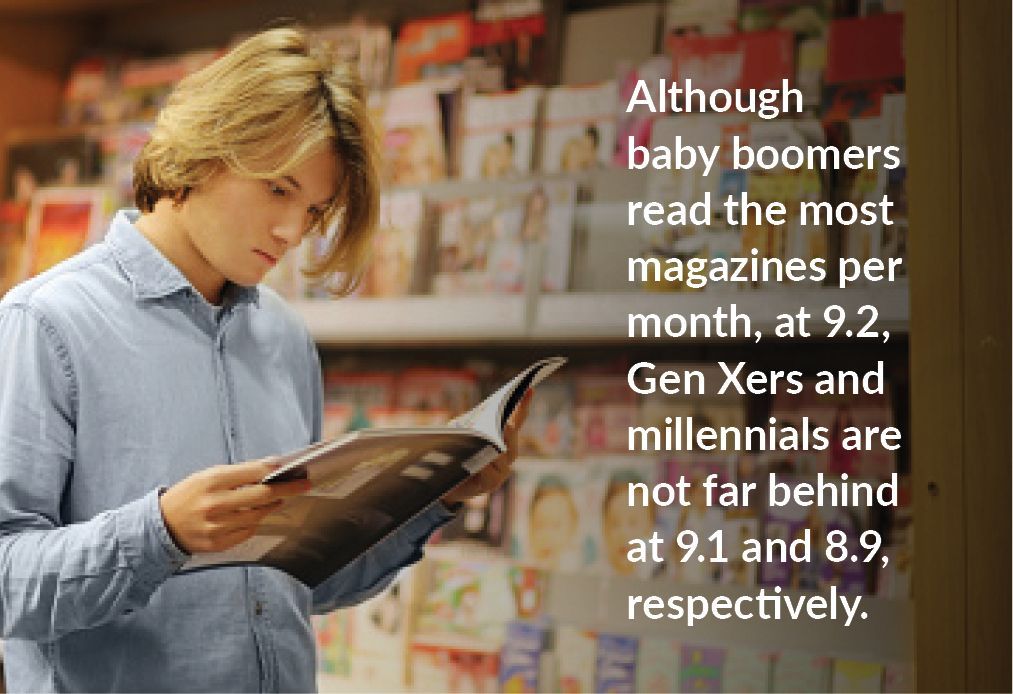In an increasingly digital world where newspapers are struggling to survive, many people expected printed media to die. It hasn’t turned out that way. The 78.2 million people born between 1995 and 2012 value print, and so do the generations preceding them.
There are reasons why print is still around: it fulfills needs, the same way digital books fill needs. People like having both, the same way they like having access to television, theaters and radio. According to the Pew Research Center, which surveyed 1,520 people who were 18 or older during one year in March or April 2015 to March or April 2016, participants preferred print books to any other format. Approximately 73% read at least one book during that period. FedEx Office did a survey and found that 90% of customers would rather read content on paper than on a screen.
Consider some additional statistics about the generation born 1997-2012:
- Approximately 40% of all consumers are currently in this age bracket.
- They are digital natives. Cellphones, Google and Wi-Fi have always been part of their lives. Print is a welcome novelty, somewhat like vinyl records. (In 2019, vinyl records outsold CDs. That hadn’t happened in 40 years.)
- They spend an average of three hours per day using social media applications on their smartphones.
- They spend about an hour per week reading magazines.
- They like reading printed books more than digital ones, and think printed materials are better for learning because it is easier to focus when reading them. American College surveyed students in four countries and 300 colleges; 92% of those surveyed prefer printed course materials to tablets or computers.
- They trust printed media more than digital media. Social media and blogging are fast ways to communicate, but that speed means there’s little or no time for editing and fact-checking, and there’s also nothing to protect viewers from a barrage of online noise. The contrast with printed media such as magazines is stark. Magazines feel real, personal and — most important — they are curated to improve quality and eliminate noise.

Although baby boomers read the most magazines per month, at 9.2, Gen Xers and millennials are not far behind at 9.1 and 8.9, respectively.
Of all forms of print, U.S. newspapers seem to be in the most trouble because of lost advertising revenue. The entire industry shrank by approximately $4.5 billion between 2011 and 2018. Even major newspapers, like The New York Times and The Washington Post, have had to lay off employees despite being respected information sources for decades. One in five U.S. newspapers has gone out of business according to an article in The New York Times by Lara Takenaga, dated Dec. 21, 2019. That’s a full 20%. Many communities no longer have a reliable source of local news.
Lack of adequate coverage has caused the rise of small and independent industry publications that can focus on otherwise neglected topics. Although these publications have small staffs and small circulation sizes, their content and reach are filling a need that captures younger audiences and even the attention of legacy publications.
Please note, the current downward trajectory for U.S. newspapers may not be a permanent thing. Jeff Bezos, the CEO of Amazon, bought The Washington Post for $250 million in 2013 and has been tinkering since then with making the online version profitable. The paper’s digital subscriptions and revenue from digital advertising created two profitable years, 2017 and 2018, despite declining numbers for other newspapers in other places.
The trend in magazines is for smaller, niche-market magazines that are published less frequently than they used to be. Print magazines that have a website are considered to be more credible than digital-only websites because people think the quality is higher and more trustworthy. They are willing to pay more money in exchange for better quality.
- The Harvard Business Review used to publish 10 issues per year. In 2017, the magazine cut the number of issues down to six, added digital benefits and invested money to make the six print issues better. Subscriptions increased by 10%.
- In 2018, Bonnier Publishing decided to make its monthly Popular Science magazine into a quarterly magazine instead. It also increased the cost of a subscription. Subscription yield increased 30% in a single year because of the two changes.
Some major brands have been using sophisticated printed magazines and catalogs to build their brands further. Airbnb, Asos, Facebook, Google and Uber have all created magazines that allow them to reach their employees and customers more effectively. Some are even sold on a standalone basis, such as ASOS Magazine. ASOS sold for $1.25 per issue and had a circulation of 453,287 during the second half of 2018. The magazine has been challenging Teen Vogue and Glamour and has included content about celebrities such as Lena Dunham, Lady Gaga and Jennifer Lawrence.
Even Amazon, a company that could not exist without the internet, created a holiday toy catalog filled with QR codes and sent physical copies to many customers in November 2018 after Toys R Us went out of business. (The online PDF version had links to the Amazon website.) Amazon is continuing to produce new versions annually.
Part of what is driving the move from digital back to print is as simple as getting burned out on all things digital. When you’ve been surrounded by digital media your entire life, anything analog looks different and valuable.
For those who rely on advertising revenue, the facts about magazine ads versus digital ads are striking. MarketingProfs reports the following:
- 92% of those 18-23 like reading print content more than digital content.
- Direct-mail marketing has a response rate that is 37% higher than the response rate for email.
The combination of print and digital is a powerful one. It has even collected some names:
- Phygital
- Bricks and clicks
- Clicks and mortar
A good magazine can do something newspapers have struggled with: making money from advertisers because subscribers will read the ads in them while they are browsing through the articles. The resulting ROI is a powerful persuader for supporting print as well as digital media.
The synergy between articles and ads only works, of course, when the content is worth reading and when the content is in balance with the ads. But if even Amazon and Google have decided to make use of print and direct mail, despite being the giants of digital media, smaller companies should certainly take note.
Sources:
https://www.reutersagency.com/en/reuters-community/millennials-killed-print-will-gen-z-revive-it/
https://deadtreeedition.blogspot.com/2018/06/us-magazines-are-in-steep-decline-except.html
https://wordsworth-editions.com/blog/remember-when-printed-books-were-dying-not-anymore
https://www.geekwire.com/2018/washington-post-profitable-growing-two-years-jeff-bezos-ownership/
https://deadtreeedition.blogspot.com/2018/06/us-magazines-are-in-steep-decline-except.html
https://www.nytimes.com/2019/12/21/reader-center/local-news-deserts.html
https://www.classicfm.com/discover-music/millennials-are-going-nuts-for-vinyl-revival/
https://www.digitaltrends.com/home/amazon-toy-catalogue/
https://www.theblackfriday.com/amazon-toy-catalog.php








